
Anzac Day is a national day of remembrance in Australia and New Zealand that broadly commemorates all Australians and New Zealanders "who served and died in all wars, conflicts, and peacekeeping operations" and "the contribution and suffering of all those who have served". Observed on 25 April each year, Anzac Day was originally devised to honour the members of the Australian and New Zealand Army Corps (ANZAC) who served in the Gallipoli campaign, their first engagement in the First World War (1914–1918).

Remembrance Day is a memorial day observed in Commonwealth member states since the end of the First World War to honour armed forces members who have died in the line of duty. The day is also marked by war remembrances in several other non-Commonwealth countries. In most countries, Remembrance Day is observed on 11 November to recall the end of First World War hostilities. Hostilities ended "at the 11th hour of the 11th day of the 11th month" of 1918, in accordance with the armistice signed by representatives of Germany and the Entente between 5:12 and 5:20 that morning. The First World War formally ended with the signing of the Treaty of Versailles on 28 June 1919.

The bugle is a simple signaling brass instrument with a wide conical bore. It normally has no valves or other pitch-altering devices, and is thus limited to its natural harmonic notes, and pitch is controlled entirely by varying the air and embouchure.

Ypres is a Belgian city and municipality in the province of West Flanders. Though the Dutch name Ieper is the official one, the city's French name Ypres is most commonly used in English. The municipality comprises the city of Ypres/Ieper and the villages of Boezinge, Brielen, Dikkebus, Elverdinge, Hollebeke, Sint-Jan, Vlamertinge, Voormezele, Zillebeke, and Zuidschote. Together, they are home to about 34,900 inhabitants.
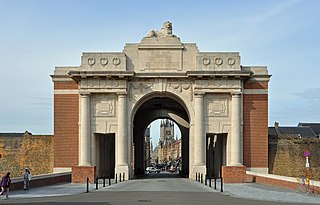
The Menin Gate, officially the Menin Gate Memorial to the Missing, is a war memorial in Ypres, Belgium, dedicated to the British and Commonwealth soldiers who were killed in the Ypres Salient of World War I and whose graves are unknown. The memorial is located at the eastern exit of the town and marks the starting point for one of the main roads that led Allied soldiers to the front line.

"Taps" is a bugle call sounded to signal "lights out" at the end of a military day, and during patriotic memorial ceremonies and military funerals conducted by the United States Armed Forces. The official military version is played by a single bugle or trumpet, although other versions of the tune may be played in other contexts. It is also performed often at Girl Guide, Girl Scout, and Boy Scout meetings and camps. The tune is also sometimes known as "Butterfield's Lullaby", or by the first line of the lyric, "Day Is Done". The duration may vary to some extent.
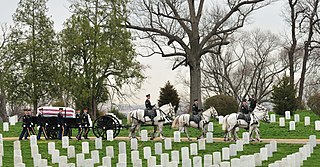
A military funeral is a memorial or burial rite given by a country's military for a soldier, sailor, marine or airman who died in battle, a veteran, or other prominent military figures or heads of state. A military funeral may feature guards of honor, the firing of volley shots as a salute, drumming and other military elements, with a flag draping over the coffin.

"Reveille", called in French "Le Réveil" is a bugle call, trumpet call, drum, fife-and-drum or pipes call most often associated with the military; it is chiefly used to wake military personnel at sunrise. The name comes from réveille, the French word for "wake up".
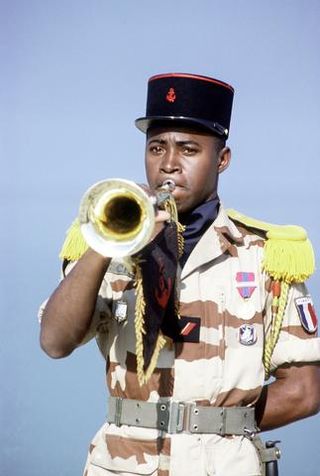
A bugle call is a short tune, originating as a military signal announcing scheduled and certain non-scheduled events on a military installation, battlefield, or ship. Historically, bugles, drums, and other loud musical instruments were used for clear communication in the noise and confusion of a battlefield. Naval bugle calls were also used to command the crew of many warships.
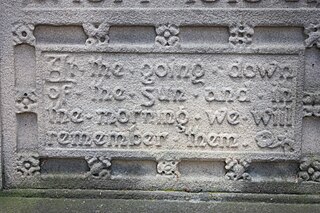
"For the Fallen" is a poem written by Laurence Binyon. It was first published in The Times in September 1914. It was also published in Binyon's book "The Winnowing Fan : Poems On The Great War" by Elkin Mathews, London, 1914.
"First Call" is a bugle call with three distinct meanings.

"The Rouse" is a bugle call most often associated with the military in Commonwealth countries. It is commonly played following "Last Post" at military services. It is sometimes called the "Reveille" or the "Levet".
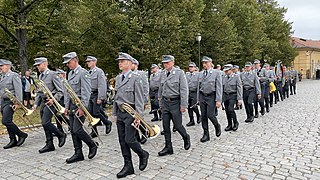
Martial music or military music is a specific genre of music intended for use in military settings performed by professional soldiers called field musicians. Much of the military music has been composed to announce military events as with bugle calls and fanfares, or accompany marching formations with drum cadences, or mark special occasions as by military bands. However, music has been employed in battle for centuries, sometimes to intimidate the enemy and other times to encourage combatants, or to assist in organization and timing of actions in warfare. Depending on the culture, a variety of percussion and musical instruments have been used, such as drums, fifes, bugles, trumpets or other horns, bagpipes, triangles, cymbals, as well as larger military bands or full orchestras. Although some martial music has been composed in written form, other music has been developed or taught by ear, such as bugle calls or drum cadences, relying on group memory to coordinate the sounds.

The Cenotaph is a war memorial constructed in 1923 and located between Statue Square and the City Hall in Central, Hong Kong, that commemorates the dead in the two world wars who served in Hong Kong in the Royal Navy, British Army and Royal Air Force. Built in stone, it is an almost exact replica of the Cenotaph on Whitehall in London, UK. It is listed as a monument under the Antiquities and Monuments Ordinance.

A corps of drums, sometimes known as a fife and drum corps or simply field music, is a traditional European military music formation. Historically, a Corps of Drums' primary role was communication. Today, the primary role of a Corps of Drums is ceremonial, performing in parades and military ceremonies. Besides drums, this formation may contain a variety of instruments, including trumpets, bugles, and fifes.

The Mexican Armed Forces have a number of bugle and trumpet calls for the different branches. Drums and bugles are used to signal the various calls for most units of the Army, Navy and Air Force while the cavalry trumpet is used to signal calls for the cavalry units of the Army, Army artillery units and the Air Force. Many of the calls and signals listed below are also used by civilian drum and bugle bands.

"Sunset", also known as the "Retreat Call", is a bugle call played in United Kingdom and British Commonwealth countries to signal the end of the official military day. In common with all bugle calls, it consists only of notes from a single overtone series. This allows it to be playable on a bugle or equivalently on a trumpet without moving the valves.
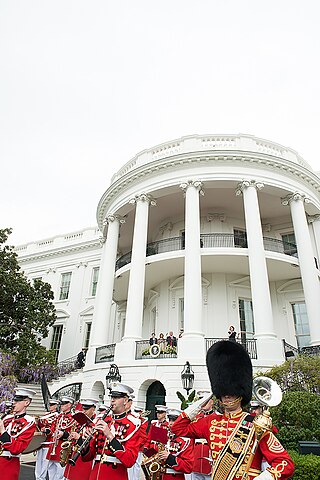
United States military music customs are the traditional, regulatory, and statutory provisions that guide performances by United States military bands during drill and ceremony and state occasions.
"La Sonnerie aux Morts" is a bugle call of the French Armed Forces used at funerals and the commemoration of battles and wars.

A fanfare trumpet, also called a herald trumpet, is a brass instrument similar to but longer than a Regular trumpet, capable of playing specially composed fanfares. Its extra length can also accommodate a small ceremonial banner that can be mounted on it.




















